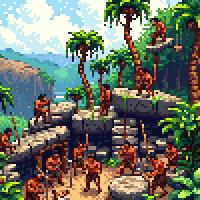Train Like a Caveman: Unlock Your Primal Strength
Modern gyms are full of machines, screens, and specialized equipment—but what if the key to real, functional strength lies in the past? Our ancestors didn’t have squat racks or treadmills, yet they were strong, resilient, and capable of enduring harsh, unpredictable environments. The secret? Primal movement, natural resistance, and survival-based fitness.
As a strength coach, I don’t train myself—or my clients—exclusively in a primal style. This isn’t about throwing away barbells and chasing deer barefoot. But the core idea of natural, evolutionary movement is always present. I constantly look for ways to integrate it: in warm-ups, in mobility flows, in conditioning circuits, and in strength patterns that mimic real-world demands.
If you want to train like a caveman, it doesn’t mean rejecting modern methods—it means grounding your training in what the human body was built to do. So ditch the idea that more machines mean more progress, and embrace raw, functional workouts that build strength you can actually use.
1. Move Like Your Ancestors
Cavemen didn’t lift weights for aesthetics—they moved for survival. Their daily activities built full-body strength and endurance. To train like them, focus on natural, full-range movements:
- Crawling - Mimics how early humans moved before walking. Great for core and shoulder stability.
- Climbing – Builds grip strength and upper body endurance. Try rope climbing or scaling trees.
- Jumping – Think explosive power: broad jumps, box jumps, and one-legged hops.
- Running & Sprinting – Alternate between brisk long-distance walks and high-speed sprints and everything in between.
 Fitness Deficiency Syndrome
Fitness Deficiency Syndrome
2. Lift Heavy, Odd Objects
Cavemen didn’t have neatly balanced barbells—they lifted heavy, awkward things. Training with unbalanced weights builds stabilizer muscles and real-world strength. Try:
- Stone Lifting – Pick up and carry heavy rocks or sandbags.
- Log Presses – Lift and press logs or tree branches overhead.
- Kettlebells & Clubs – Mimic ancient tools for rotational strength and grip power.
- Farmer’s Carries – Walk with heavy, uneven objects in each hand to build core stability.
3. Train in Nature
Forget the treadmill—nature is the best gym. Uneven terrain forces your body to stabilize and react dynamically. Train outside by:
- Running on trails instead of a treadmill.
- Doing bodyweight workouts on rocky or grassy terrain.
- Using trees and rocks for pull-ups, step-ups, or balance training.
Exposure to sunlight, fresh air, and natural elements toughens the body and mind.
4. Engage in Combat & Play
Cavemen weren’t just about brute strength; they honed their bodies through fighting, hunting, and play. Engage in activities that build endurance, agility, and coordination:
- Wrestling & Grappling – Great for full-body endurance and functional strength.
- Throwing & Striking – Use medicine balls, spears, or even a homemade spear-thrower.
- Obstacle Courses – Climb, crawl, and jump like you're chasing prey—or escaping danger.
5. Eat & Recover Like a Caveman
Your training is only as good as your recovery. Follow these primal habits:
- Eat Whole Foods – Prioritize meat, fish, vegetables, nuts, and fruits—no processed junk.
- Rest Deeply – Sleep in sync with the sun, avoid screens before bed, and wake naturally.
- Cold Exposure & Heat Therapy – Alternate between cold showers, ice baths, and sauna-like heat to improve circulation and resilience.
Final Thoughts: Reclaim Your Primal Power
Cavemen were strong, mobile, and resilient—not because they trained in a gym, but because they moved with purpose in the real world. By adopting their movement patterns, lifting heavy objects, training outdoors, and eating naturally, you can build a body that’s not just fit but truly powerful.
As I mentioned earlier: this isn’t about trading your training plan for a loincloth and a log—it’s about making modern strength training less… domesticated. Natural movement and real-world resilience deserve a place in every plan—smartly, progressively, sustainably. I don’t train this way exclusively, and I don’t expect you to. But primal thinking sharpens everything I build.
 Ditch the machines. Train like a caveman.
Ditch the machines. Train like a caveman.
DANGER: Modern Life Has Made You Weak!
Let’s be real: most of us have spent years sitting in chairs, hunched over screens, and moving far less than our ancestors did. If you think you can suddenly jump into caveman training without consequence, prepare for a rude awakening. Your joints, tendons, and muscles need time to adapt.
Going head over heels into this without preparation is like deciding to wrestle a bear because you watched a nature documentary—bad idea. Your wrists, shoulders, back, and hips especially need gradual strengthening. Mobility work and progressive training are key.
Get professional guidance if possible. From my point of view, training on your own is often a waste of time—poor form, overtraining, and injury risks make it a gamble. A good coach will make sure you progress safely and efficiently. Don’t let your ego turn you into a limping, regretful caveman.

